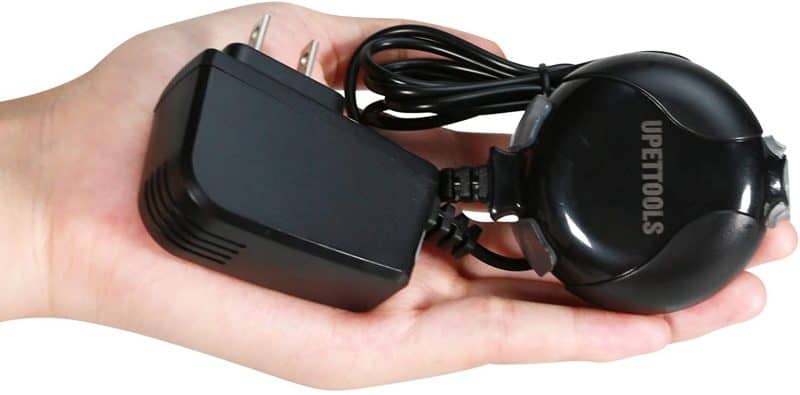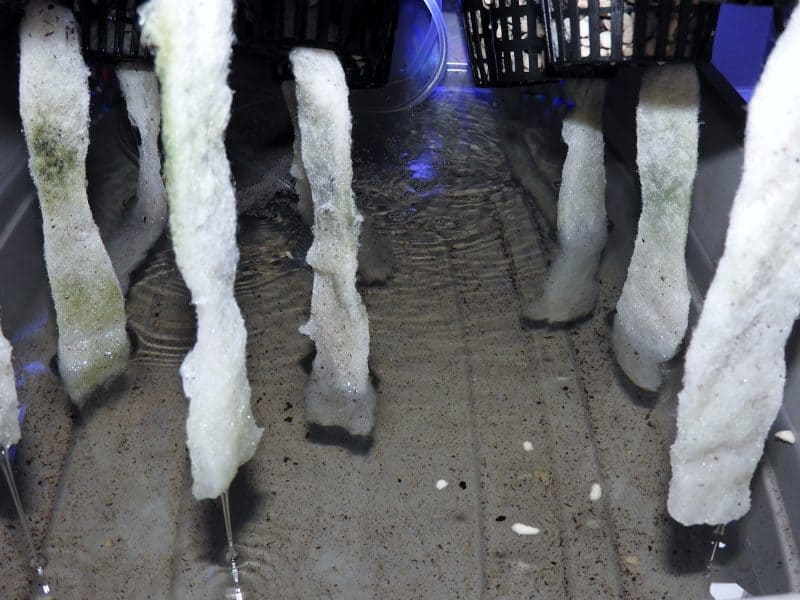This post contains affiliate links. If you buy something from one of our links we may earn a commission. Thanks
Explore the ease and simplicity of a hydroponic wick system, the perfect solution for efficient and effortless indoor gardening.
Hydroponic Wick System Key Takeaways:
- A hydroponic wick system is a passive, soil-less growing method where plants receive water and nutrients through a wick from a reservoir.
- It’s ideal for small plants like herbs and lettuce, requiring minimal setup and maintenance, making it perfect for beginner gardeners or those with limited space.
Dive into the world of indoor gardening with a hydroponic wick system!
This method simplifies plant care, making it a breeze for beginners and seasoned gardeners alike.
Learn how to set up your own system and watch your greens thrive with minimal effort.
Hydroponic Wick System: Easy Kratky On Steroids
So what is a hydroponic wick system you ask? A hydroponic wick system is a method of growing where plants are watered through a wick instead of a pump.
It can be a passive hydroponic system that uses no airstones or it can be turbocharged by using an air pump.
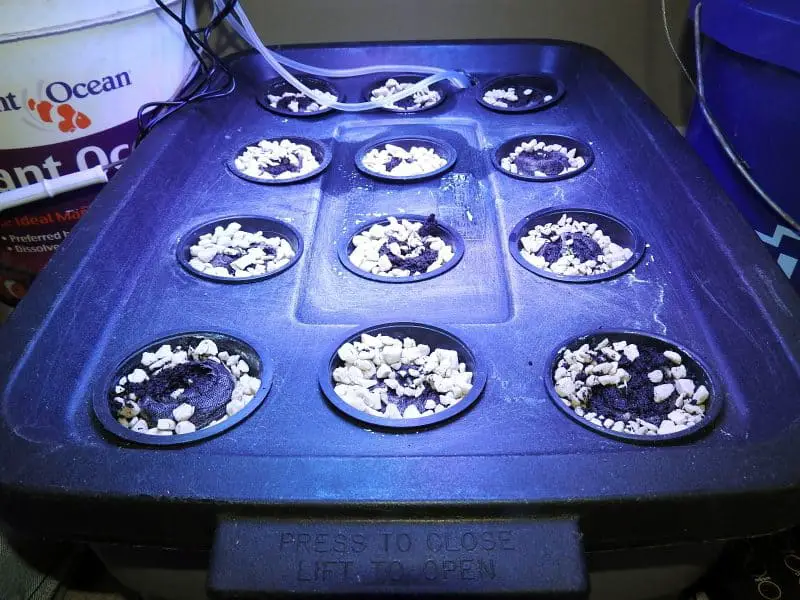
A hydroponic wick system is very similar to the Kratky method of growing where plants are drawing all water directly from the reservoir via its roots. Here each pot is watered by a wick via capillary action in addition to having roots in the reservoir.
Both are forms of sub-irrigated planters or SIPs because they are watered from below instead of being top watered. The Kratky system is a true self watering planter because it is only filled at the start of a grow.
How Much Does A Wick Hydroponic System Cost?
If you had to buy everything it would cost about $50 -60. But if you already have a tote (about $12) it would be less. You will probably need to buy net pots for about $ 10.
An air pump is optional about $18. I don’t count seeds or starter plugs or soil or coco because you need those no matter how you grow.
You will need some wicking material. Old polyester blankets or clothes will work or you can buy some polyester batting for about $10 last time I checked. You probably have a drill and a hole saw would come in handy but you can cut the holes out manually.
A hydroponic wick system is really a very simple and inexpensive DIY project. It is a great system for beginners too!
Hydroponic Wick System Materials
- You will need a tote with a lid. I used a 10-gallon tote
- I use 3-inch net pots in my system
- You will need a 2 7/8 hole saw to cut holes for them in the lid. You might be able to cut holes by hand (not recommended)
- You will need wicks which I cut from polyester batting but even an old blanket can be used to cut some wicks.
- Start seedlings in rock wool, starter plugs, or coco. Backfill the net pots with hydroton or perlite.
- You will need seedlings. Lettuce works great. One per hole.
- Airstones. Optional but recommended.
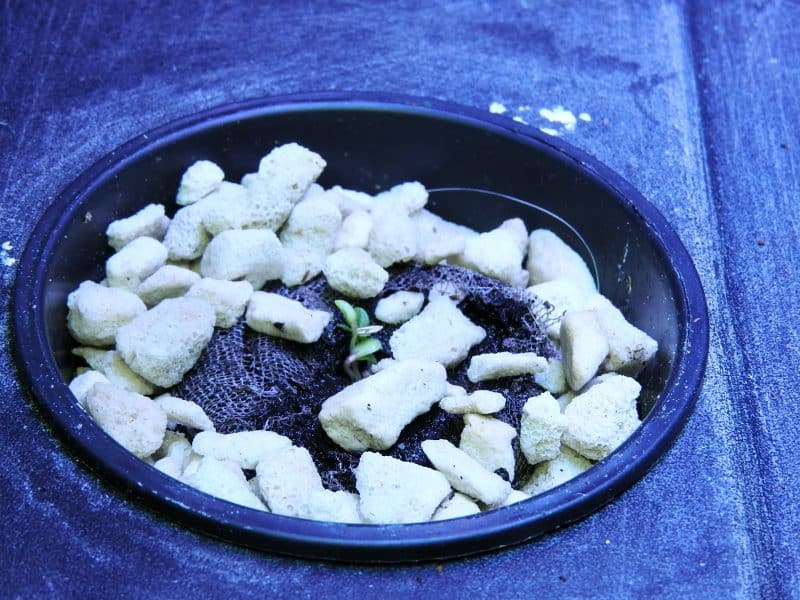
Wick System Hydroponics Pros And Cons
Pros:
- It is simple and beginner friendly
- Cheap setup costs
- Minimal maintenance required
- Does not need electricity
- Perfect for greens and lettuce
Cons:
- Not for larger plants like tomatoes and peppers
- Wicking can only move a limited amount of water
- The reservoir can grow bacteria like Pythium
- The nutrient solution can become too strong or unbalanced
Build The Best Hydroponic Wick System
Here you can see the net pot filled with media and a jiffy pellet and the wick hanging down.
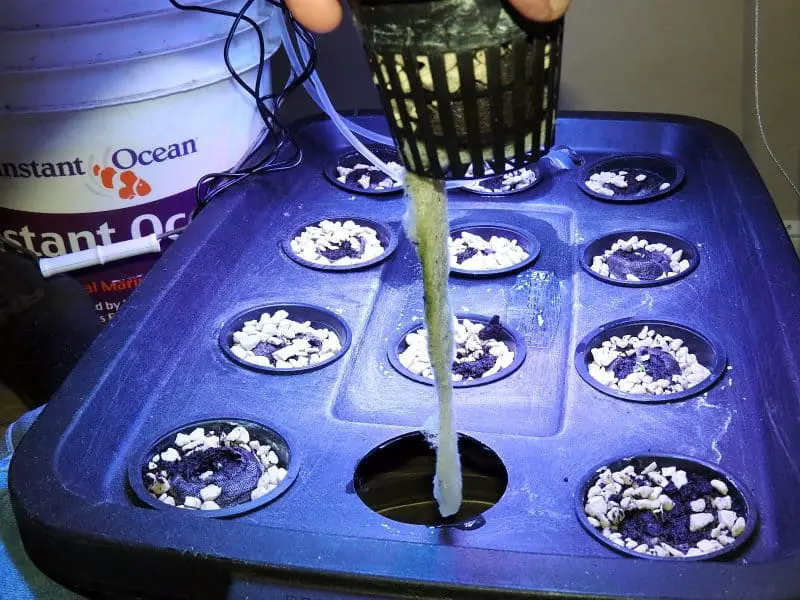 With the Kratky method, you only fill the reservoir once at the start. Plants grow until the water is used up. Adding more would drown the existing air roots. That is why a Kratky system is best for small fast growing plants. But there is a fix for this.
With the Kratky method, you only fill the reservoir once at the start. Plants grow until the water is used up. Adding more would drown the existing air roots. That is why a Kratky system is best for small fast growing plants. But there is a fix for this.
Why To Add Air Stones To Your Hydroponic Wick System
If you add airstones to your wicking system you can keep your plants healthier and add more water as needed. Adding wicks will enhance water uptake. Just maintain the same nutrient level throughout your grow.
Start with the water level slightly above the bottom of your net pots. Let it drop a few inches and maintain this level until you are done harvesting.
With airstones added you can monitor your nutrient solution, top up your reservoir or even do a complete water change.
Yes, they do use electricity but not very much and there are some silent ones out there. Here is what I use. One per 10 gallons.
Hydroponic Wick System – Kratky On Steroids
I started 6 leaf lettuce and 6 buttercrunch plants in jiffy pellets. You can do any number you want but remember they will need room to grow.
I was planning on growing Kratky lettuce but sometimes we need to be flexible and make adjustments. I planted my seeds in jiffy pellets with the idea of setting them in peat pots filled with coco.
When the pots came I realized they were larger than the pots I had before and would not fit in my net pots. I did not want loose coco falling into my reservoir so I decided to plant my peat pellets and fill the pots in with growstones instead.
I was concerned not enough water would get to the top of the plants and the peat pellets would be too dry. Once the peat dries it is very hard to get it wet again. So I decided to add a wick to my Kratky grow to provide more water to the pellets.
Hydroponic Wick System DIY
You will want to start your plants a week or two before you want to put them in your wicking system. Ideally, they will have roots starting to poke out.
My Rubbermaid tote holds 10 gallons and is roughly 24 inches long by 16 inches wide.
Decide how many plants you want and mark off evenly spaced holes in the lid. If you use 3-inch net pots you need a 2 7/8 hole saw if you used a 3-inch one the holes would be too big and the pots would fall through the holes.
I have 12 slots in the lid and actually, with that many plants, it is really a hydroponic wicking bed.
I plan on removing the leaf lettuce early so the buttercrunch will have more room to grow.
How Do You Make A Hydroponic Wick?
Here is a peek under the hood. You can get polyester batting that I use for my wicks on Amazon or at any JOANN store. That is your best bet.
Many blankets are made from polyester too but some are treated with fire retardant or other chemicals and may not be safe. Don’t use cotton or it will rot.
Just cut your material into strips. Mine are about 1 inch wide and maybe a foot long. Stick one end through the mesh in the bottom of your net pot and pull enough through to fold it over.
Add your seedling and make sure the bottom sets on the wick. Then fill in around it. I used growstones but you can use perlite, hydroton coco, or potting soil.
Ideally, you want something inert. Starter plugs like Rapid Rooters work great for seedlings too. Coco or soil could add unwanted dirt to your reservoir.
Fill your tub with water and nutrient solution and check the water level is above the pot bottom by about an inch. Also, make sure the wicks are in the water.
The wicks need to be totally wet to move water so topwater your plants when starting out so everything is well saturated.
You should use a hydroponic fertilizer. There are many and they all will work but avoid products with organics. They don’t play well with hydroponics and can feed unwanted bacteria in your reservoir.
Your plants are being fed constantly so they need less food. I would only use half of what the recommended amount is for your brand.
I will be updating as the grow progresses so stay tuned. Here is my lettuce about a week later.
Learn about using a grow tent for vegetables
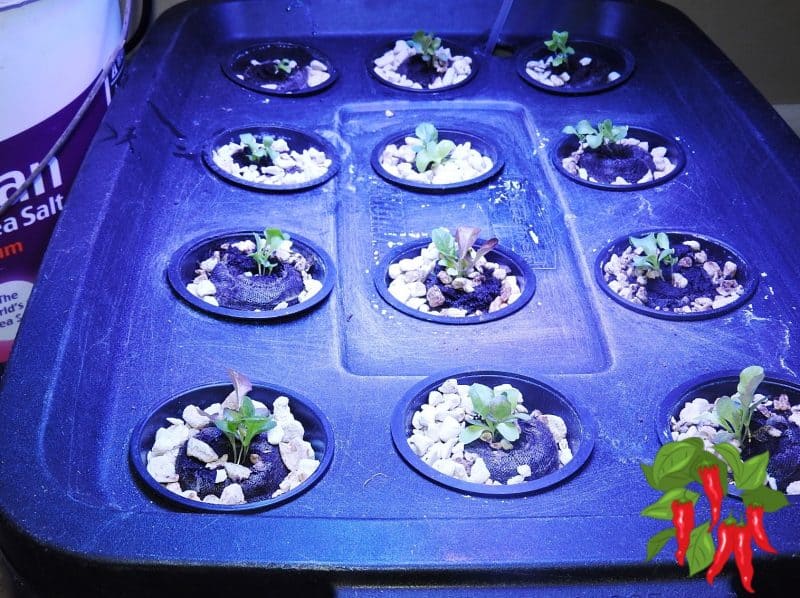
Hydroponic Wick System – Kratky On Steroids Day 30
I thinned out my lettuce plants to one per pot. Growth has been explosive since then.
The buttercrunch (bottom row) is smaller and because it heads it is going to take longer to finish than the leaf lettuce.
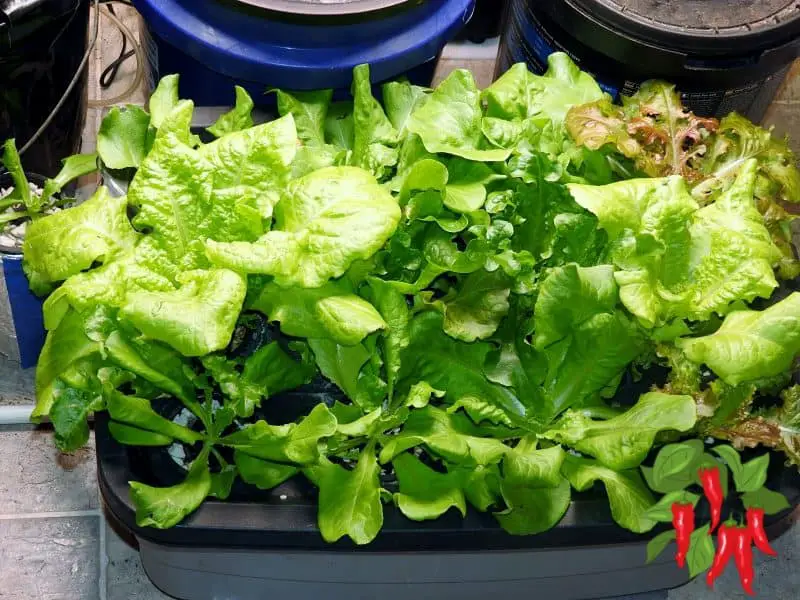
Here is a peek inside the tote.
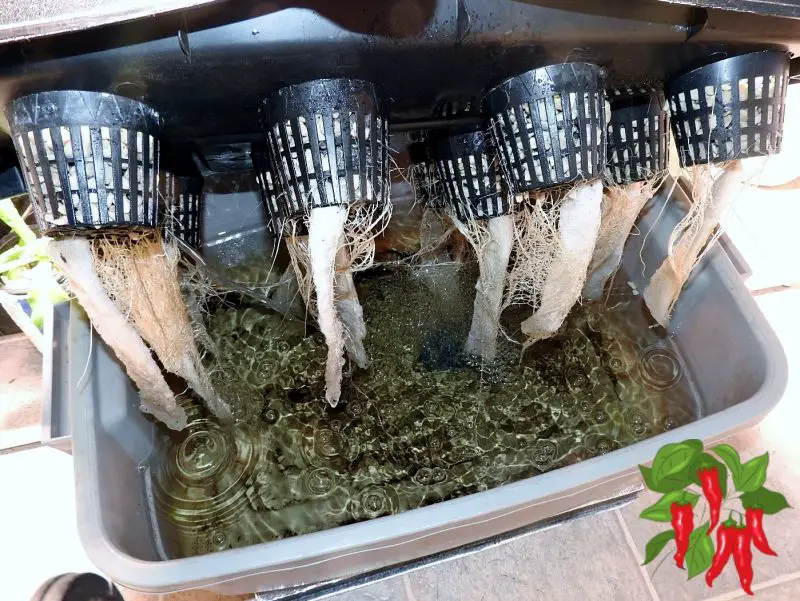
Conclusion: Embracing the Hydroponic Wick System
As we conclude our exploration of the hydroponic wick system, it’s clear that this method offers a unique blend of simplicity, efficiency, and effectiveness in indoor gardening.
Whether you’re a beginner or an experienced gardener, the hydroponic wick system adapts to your needs, providing an accessible pathway to grow a variety of plants.
Let’s summarize the key takeaways:
Ease of Use for Beginners
- Simple Setup: With basic components and straightforward assembly, starting your garden is hassle-free.
- Low Maintenance: Requires minimal monitoring and intervention, ideal for busy individuals.
Cost-Effective Gardening
- Affordable Materials: Utilizes readily available and inexpensive supplies.
- Energy Efficiency: Operates without the need for electricity, reducing ongoing costs.
Versatility in Plant Choices
- Ideal for Small Plants: Excellently supports the growth of herbs, lettuce, and other leafy greens.
- Adaptability: This can be modified to suit different plant types with minor adjustments.
Environmentally Friendly
- Water Conservation: Utilizes water efficiently, reducing waste.
- Sustainable Practice: Offers a greener alternative to traditional soil-based gardening.
In summary, the hydroponic wick system stands out as a practical, environmentally friendly, and cost-effective method for growing plants indoors.
It demystifies the process of hydroponics, making it accessible to everyone.
Embracing this system can lead to a rewarding journey of growing your own food or decorative plants, contributing to a healthier and more sustainable lifestyle.

